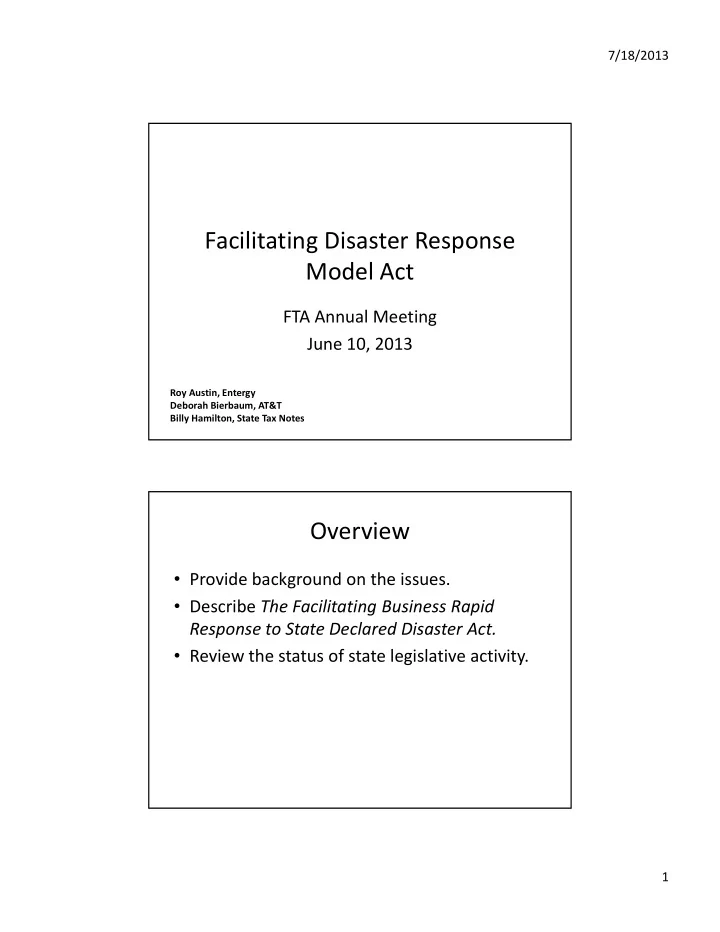

7/18/2013 Facilitating Disaster Response Model Act FTA Annual Meeting June 10, 2013 Roy Austin, Entergy Deborah Bierbaum, AT&T Billy Hamilton, State Tax Notes Overview • Provide background on the issues. • Describe The Facilitating Business Rapid Response to State Declared Disaster Act. • Review the status of state legislative activity. 1
7/18/2013 When Disaster Strikes • Disasters can sever the networks that connects societies – power lines go down, cell towers are lost, pipelines are damaged and water service fails. • Agencies and Businesses rush into the disaster zone to begin the recovery process. – Resources can be pre ‐ staged immediately out of harms way to speed up recovery. – Out ‐ of ‐ State Employees volunteer to come in and help on a temporary basis expediting the recovery process. FEMA.Gov/Disasters • Major Disaster Declarations: – 2013 to date 22 – 2012 47 – 2011 99 • All States have been impacted. Ten states with the most declared major disasters: Texas, California, Oklahoma, New York, Florida, Louisiana, Alabama, Kentucky, Arkansas, Missouri • The Stafford Act (§401) requires that: "All requests for a declaration by the President that a major disaster exists shall be made by the Governor of the affected State." 2
7/18/2013 The Issue • Applying normal tax and regulatory requirements during a disaster creates unnecessary obstacles. • Requiring businesses and employees to go through the often slow and burdensome process of ensuring that the business and employees are in compliance with state regulatory, tax and licensing laws and regulations can throw roadblocks in the way. The Solution • The Facilitating Business Rapid Response to State Declared Disaster Act recognizes the temporary nature of the work and the need for rapid response to help a state recover from a disaster of emergency. • The model Act was adopted by the American Legislative Exchange Council (ALEC) and by the National Conference of State Legislatures (NCSL). • This is not a Federal legislative bill. It is a model act that states can adopt. • This is not about revenue. 3
7/18/2013 Key Provisions of the Act • Invoked by: – Governor State of Emergency Proclamation – Presidential Declaration of a Federal Major Disaster, or – Designation by other authorized state official. • Applies to “Disaster or Emergency Related Work” Means repairing, renovating, installing, building, rendering services or other business activities that relate to “infrastructure” that has been damaged impaired or destroyed by the Declared State Disaster or Emergency. Key Provisions of the Act Infrastructure is limited to the property and equipment owned or used by communications networks, electric generation, transmission and distribution systems, gas distribution systems, water pipelines, and public roads and bridges and related support facilities that service multiple customers or citizens. 4
7/18/2013 Key Provisions of the Act • Out ‐ of ‐ state companies, out ‐ of ‐ state employees and their affiliates entering a state at the request of the instate registered business or the State for a “State Declared Disaster or Emergency” for repairing “infrastructure” would not be subject to the normal presence or doing business standards. • This includes all state or local business licensing or registration requirements or state and local taxes and fees during the “Disaster Period”. Key Provisions of the Act • However, Out ‐ of ‐ state companies and out ‐ of state employees will pay transaction taxes (fuel taxes, sales/use tax, hotel tax, etc.) on purchases while in the state. • The “Disaster Period” begins within ten days of the first day of the declaration or designation and extends for a period of sixty calendar days after the end of the “Declared State Disaster or Emergency”. • Any business or individual that remains in the state beyond the Disaster Period will become subject to taxes and regulatory filings that ensue going forward. 5
7/18/2013 Why it Matters • Removing the barriers to efficient deployment of resources to the hardest hit areas will: – Decrease the response time for companies to deploy staff to affected community allowing them to provide needed resources to first responders and customers faster. – Reduce the disincentives and headaches for employees which will encourage volunteers to pitch in during times of need. Current Legislative Activity State Bill # Status Delaware HB145 Passed House, discussions underway in Senate. Indiana HB1546 Passed both Houses, Governor vetoed as part of a larger package unrelated to model act. Maine LD1836 ENACTED in 2012. Maryland HB1513 ENACTED. Took effect June 1, 2013. New York A7340 Passed favorably out of Assembly and Senate Committees S5323 North Carolina HB0335 Legislative staff revisions and discussions underway South Carolina HB3710 Proviso amendment to Appropriations Bill passed Senate. If enacted would be 1 year and General Assembly would need to adopt permanent law. 6
7/18/2013 Disaster Recovery Legislation helps Infrastructure Companies to get their customers back in service faster 7
Recommend
More recommend